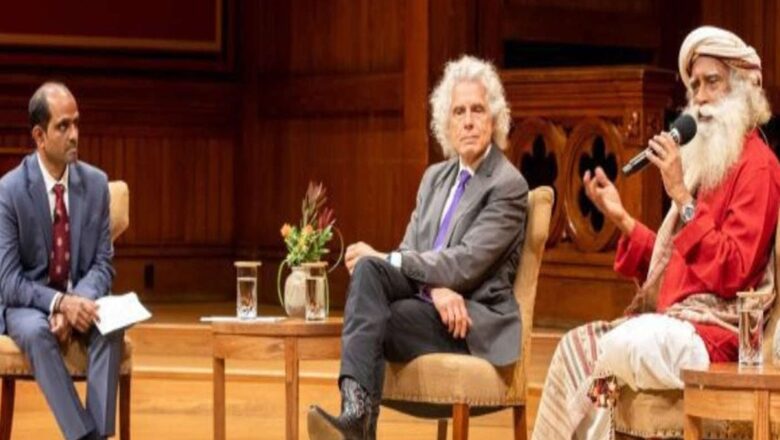
views
I was struck by watching the recent discussion on ‘Is Consciousness a Miracle?’ between Sadhguru and Steven Pinker, Professor of Psychology at Harvard. Although the question for discussion was not well chosen, both speakers did their best to overcome its constraints and relate their responses. After all, both are engaging representatives of their fields of expertise. When I refer to their being representatives, I mean that they stand for something greater in terms of the kind of knowledge that they pursue and teach others. They speak for their fields, as it were, not merely their experiences. At least that is how I would like to enter into reflecting on their exchange.
The striking part of the conversation was not so much what each had to relate about their field, though that is important, but rather how it demonstrated the interaction between their fields. It should make us ask serious questions about how different fields of knowledge across the world interact with each other. Different cultures in the world have developed different means for reflecting on experience by producing different kinds of sciences. How their practitioners can work together will partly condition how human progress develops.
An analogy of their interaction, albeit inexact, can be found in the philosophy and sociology of science. More than half a century ago, Thomas Kuhn proposed a Structure of Scientific Revolutions in an influential book carrying that very name. While the process of how scientific revolutions happen is interesting in itself, along the way, Kuhn talked about the phenomenon of paradigms, which are composed of a theory or set of theories which govern the conduct of science among groups of scientists working in their fields. This seems a useful heuristic for us to think about, say, cognitive science as Pinker conceives it or enlightenment science as Sadhguru conceives it. Each works within its own paradigm.
An interesting question in the philosophy and sociology of science is whether and how one group of practitioners communicates with and understands the other. The general assumption is that each does so from within the framework of their own paradigm, which provides the technical or theoretical language they work within. But paradigms may also erect limitations because scientists working within one paradigm may not easily grasp what those in the other one are saying. Kuhn and others refer to this as the problem of incommensurability, which takes different forms.
Although it is easy enough to declare that Sadhguru and Pinker work within their own scientific paradigms, it isn’t clear to me that both sides of the conversation would accept this description. In fact, I am fairly convinced that Pinker does not accept Indian enlightenment science as a form of science or knowledge at all and that it should be treated with seriousness as such. It also seemed to me that Pinker experiences greater limitations emerging from the assumptions according to which he works. The reverse was not the case in quite the same way, however. Sadhguru’s starting point seems to be that Pinker does represent some field of science or knowledge and he accepts Pinker as an expert or specialist.
The asymmetry goes beyond that. Listening to Sadhguru, one got the impression that he could accommodate the concepts, findings and theories that Pinker works within. He could also account for them and provide some critique of the limitations in their methodology (e.g. data derived from sensory perception) and scope of inquiry (e.g. whether there is a realm beyond the physical). Whereas it isn’t clear that Pinker was able to grasp what Sadhguru was saying, let alone accept the limitations that the latter identified.
How should we account for this difference? It seems to me that Pinker is committed to the limitation that comes from insisting that the ‘consciousness’ of human beings can be put down to some sort of brain activity. Claims to go beyond that in cases such as extra sensory perception or telekinesis were, for Pinker, without evidence and fictional, if not fraudulent. It was not Sadhguru who referred to extrasensory perception or telekinesis but Pinker who spontaneously produced them. This seemed like the only way in which Pinker could grasp and structure what Sadhguru was saying. It seemed as though the limitations, including the ones that Sadhuru has correctly identified, were the very ones that were preventing Pinker from acknowledging that Sadhguru also operates in some scientific domain or paradigm.
These limitations of Pinker and his field appear to arise from his own Western cultural background. In his view, the enlightenment that took place in the West shook off religious shackles and grounded knowledge on rational foundations. In this view, the paradigm Sadhguru works within was that which the enlightenment had displaced. This is despite the fact that Sadhguru pointed out more than once that he was not speaking from the kind of religious background that Pinker had rejected. In other words, Sadhguru’s cultural background lies not in the heritage of Semitic religions rejected by Pinker but in the paradigm of Indian enlightenment science.
Not only did Pinker reduce the scope of inquiry by the limitations introduced by rationality, but he feels justified, even if erroneously so, by conflating the religious traditions that he rejects with the Indian paradigm. It is no wonder that Pinker does not see Sadhguru as a practitioner of any kind of science, but maybe as just some kind of charlatan. Although Pinker was far too polite to say so explicitly, that seems a plausible explanation for his dismissiveness and demeanour throughout the conversation.
What do we learn from the exchange and the differences it throws light on?
It seems evident that those from the Western culture have erected many limitations to the kind of knowledge offered by Indian enlightenment science. Meanwhile, Indian enlightenment science is capacious enough to listen to and understand the extent to which Western natural sciences are progressing and to account for their success as well as their limitations. I would like to name this as a case of asymmetrical incommensurability.
Broadening this out, one can see how those who have been socialised in a culture such as India have little difficulty in practising their traditions while also being often very good practitioners of the natural sciences. Their culture is capacious enough for them not to feel trapped in a sort of cognitive dissonance while being practitioners of both. But the reverse is less often true. We can find Western people who experience a great deal of difficulty in being able to access enlightenment science without first ensuring that it does not represent some aspect of the religious tradition they have rejected in favour of rationality. In that sense, Pinker’s difficulties are not his own or even of his own making. They are cultural limitations which produce the constraints for the way in which his paradigm can function.
The writer is a Reader in Culture and Law at Queen Mary, University of London. He is author of Against Caste in British Law (Palgrave, 2015) and co-editor of Western Foundations of the Caste System (Palgrave, 2017). Views expressed in the above piece are personal and solely that of the author. They do not necessarily reflect News18’s views.




















Comments
0 comment